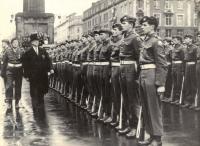The FCA
Published in 20th-century / Contemporary History, Issue 2(March/April 2012), Letters, Volume 20
President Eamon de Valera inspecting a guard of honour, provided by B Company of the FCA’s 7th Battalion, outside the GPO on Easter Sunday, early 1960s. The battalion commander was enraged at the 50% turnout at a rehearsal a few weeks earlier. (Irish Press)
Sir,—I found your article on the FCA (HI 19.4, July/August 2011) very interesting. I served in the FCA in Mullingar. We would spend almost an entire year training young men to be efficient gunners. We would then go to camp in the Glen of Imaal and give a good account of ourselves. The men would get paid . . . and that was the last that we would see of many of them: they used the money to pay their fares and emigrated. So we had to start all over again with raw recruits.
I used to go out to Ballinacarrgy one night per week to train the men there. The accommodation, ironically, was a hall belonging to the British Legion. On winter nights the men would come in with rifles slung over one shoulder and a couple of sods of turf under the other arm to light the fire to keep us warm. Men in rural units kept their rifles at home but were never issued with ammunition, as stated by Dr Louis O’Brien in his history of the Pearse Battalion. Indeed, every round expended at range practices had to be accounted for by counting the cartridge cases and the registers sent to command HQ.
The uniform was bullswool but not of the pattern worn by the regulars. There was a short tunic that stopped at the waist, which distinguished them from that worn by the regulars. This would have been a disadvantage in combat, as an enemy on capturing a prisoner or seeing a casualty would know that his opponents were semi-trained part-time soldiers.
It is true that the Lee-Enfield No. 4 rifle was used in the Congo, not only by the Irish but also by the Indian Army, but it was obsolescent by the mid-’50s. Apart from Bren and Vickers machine-guns, by the late 1950s the infantry were equipped with Swedish Gustaf sub-machine-guns and Belgian Energa anti-tank grenades. The early ’60s saw the introduction of 60mm mortars. In 1958 we had 25-pounder howitzers and appeared to have had them for some time. I presume that this applied to the other FCA batteries.
The FCA was always regarded as the poor relation by the permanent defence forces (PDF). Regular units were commanded by lieutenants-colonel, FCA ones by commandants, the equivalent of majors in most other armies. A good example of this lack of understanding was illustrated by an incident in 7th Battalion in the early 1960s. B Company was tasked with providing a guard of honour for President de Valera outside the GPO at the annual Easter parade. A rehearsal was held a couple of weeks in advance on a Thursday night. The turnout was only about 50%. The battalion commander, a newly appointed regular commandant, was enraged. Another rehearsal was scheduled for the following week. ‘They will just have to turnout next week’, said the battalion OC. ‘But that’s just it, sir,’ said a platoon commander, ‘They don’t have to turnout.’ When in the early 1960s the FCA 7th Battalion competed in the first integrated all-army shoot they came second, running a PDF unit very close. The champion shot was a young FCA private from Artane. There was never another integrated championship.
One night a few of us were having drinks in the mess in Gormanston. Unknown to us, one of the company was a senior employee of the revenue commissioners. Somebody brought up the question of income tax on our pay from camp. We all said that we did not declare it. A few weeks later I got a letter saying ‘Please state your income tax number’. I duly complied. Shortly thereafter a letter arrived from the revenue with a new and increased income tax assessment. I wrote to query this and got a one-line reply: ‘Army pay 1953 to 1968’. Our brother officer, as he was obliged to do, had shopped us all.—Yours etc.,
BRIAN P. Ó CINNEIDE
Durban, SA
















